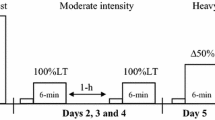Summary
To test the hypothesis that a smaller quantity of high intensity (HI) as opposed to a larger quantity of moderate intensity (MI) swim training would result in adaptations more specific to the short performance times of swimming competitions, two groups of elite university swimmers were tested before and after 6.5 weeks of specific HI or MI intermittent swim training. In training, swimming times were faster and blood lactate concentrations were higher (10.2 vs. 7.5 mM) during HI compared to MI training. No significant differences were observed between the two groups for any of the variables measured, before or after training. However, significant increases with training were observed for the activities of hexokinase, phosphorylase, phosphofructokinase, succinate dehydrogenase, and 3-hydroxyacyl CoA dehydrogenase in the deltoid, but not the gastrocnemius muscles. Training resulted in significant increases in \(\dot V\)O2 max during treatmill running, but not during tethered swimming. It is concluded that a larger quantity of MI swim training results in physiological adaptations that are similar to those obtained with a smaller quantity of HI training, at least over a relatively short training period.
Similar content being viewed by others
References
Bergström J (1962) Muscle electrolytes in man. Scand J Clin Lab Invest [Suppl] 68: 1–110
Bonen A, Wilson BA, Yarkony M, Belcastro AN (1980) Maximal oxygen uptake during free, tethered and flume swimming. J Appl Physiol 48: 232–235
Clausen JP (1977) Effect of physical training on cardiovascular adjustments to exercise in man. Physiol Rev 57: 779–815
Dixon RW Jr, Faulkner JA (1971) Cardiac output during maximum effort running and swimming. J Appl Physiol 30: 653–656
Gollnick PD, Armstrong RB, Saubert IV CW, Piehl K, Saltin B (1972) Enzyme activity and fibre composition in skeletal muscle of untrained and trained men. J Appl Physiol 33: 312–319
Green HJ, Houston ME (1975) Effect of a season of ice hockey on energy capacities and associated functions. Med Sci Sport 7: 299–303
Green HJ, Thomson JA, Daub WD, Houston ME, Ranney DA (1979) Fiber composition, fiber size and enzyme activities in vastus lateralis of elite athletes involved in high intensity exercise. Eur Appl Physiol 41: 109–117
Holloszy JO, Booth FW (1976) Biochemical adaptations to endurance exercise in muscle. Annu Rev Physiol 38: 273–291
Holmér I (1972) Oxygen uptake during swimming in man. J Appl Physiol 33: 502–509
Holmér I, åstrand P-O (1972) Swimming training and maximal oxygen uptake. J Appl Physiol 33: 510–513
Holmér I, Stein EM, Saltin B, Ekblom B, åstrand P-O (1974) Hemodynamic and respiratory responses compared in swimming and running. J Appl Physiol 37: 49–54
Houston ME (1978) Metabolic responses to exercise with special reference to training and competition in swimming. In: Eriksson B, Furberg B (eds) Swimming Medicine IV. University Park Press, Baltimore, pp 207–232
Houston ME, Bentzen H, Larsen H (1979) Interrelationship between skeletal muscle adaptations and performance as studied by detraining and retraining. Acta Physiol Scand 105: 163–170
Ikai M, Ishii K, Myashita M (1964) An electromyographic study of swimming. Res J Phys Educ 7: 47–62
Lavoie J-M, Taylor AW, Montpetit RR (1980) Skeletal muscle fibre size adaptation to an eight-week swimming programme. Eur J Appl Physiol 44: 161–165
Lowry OH, Passonneau JV (1972) A flexible system of enzymatic analysis. Academic Press, New York
Magel JR, Foglia GF, McArdle WD, Gutin B, Pechar GS, Katch FI (1975) Specificity of swim training on maximal oxygen uptake. J Appl Physiol 38: 151–155
McArdle WD, Magel JR, Delio DJ, Toner M, Chase JM (1978) Specificity of run training on \(\dot V\)O2 max and heart rate changes during running and swimming. Med Sci Sports 10: 16–20
Nygaard E, Nielsen E (1978) Skeletal muscle fiber composition with extreme endurance training in man. In: Eriksson B, Furberg B (eds) Swimming Medicine IV. University Park Press, Baltimore, pp 282–293
Sawka MN, Knowlton RG, Miles DS, Critz JB (1979) Post-competition blood lactate concentrations in collegiate swimmers. Eur J Appl Physiol 41: 93–99
Author information
Authors and Affiliations
Additional information
This study was supported by a grant from the Natural Sciences and Engineering Research Council of Canada
Rights and permissions
About this article
Cite this article
Houston, M.E., Wilson, D.M., Green, H.J. et al. Physiological and muscle enzyme adaptations to two different intensities of swim training. Europ. J. Appl. Physiol. 46, 283–291 (1981). https://doi.org/10.1007/BF00423404
Accepted:
Issue Date:
DOI: https://doi.org/10.1007/BF00423404




